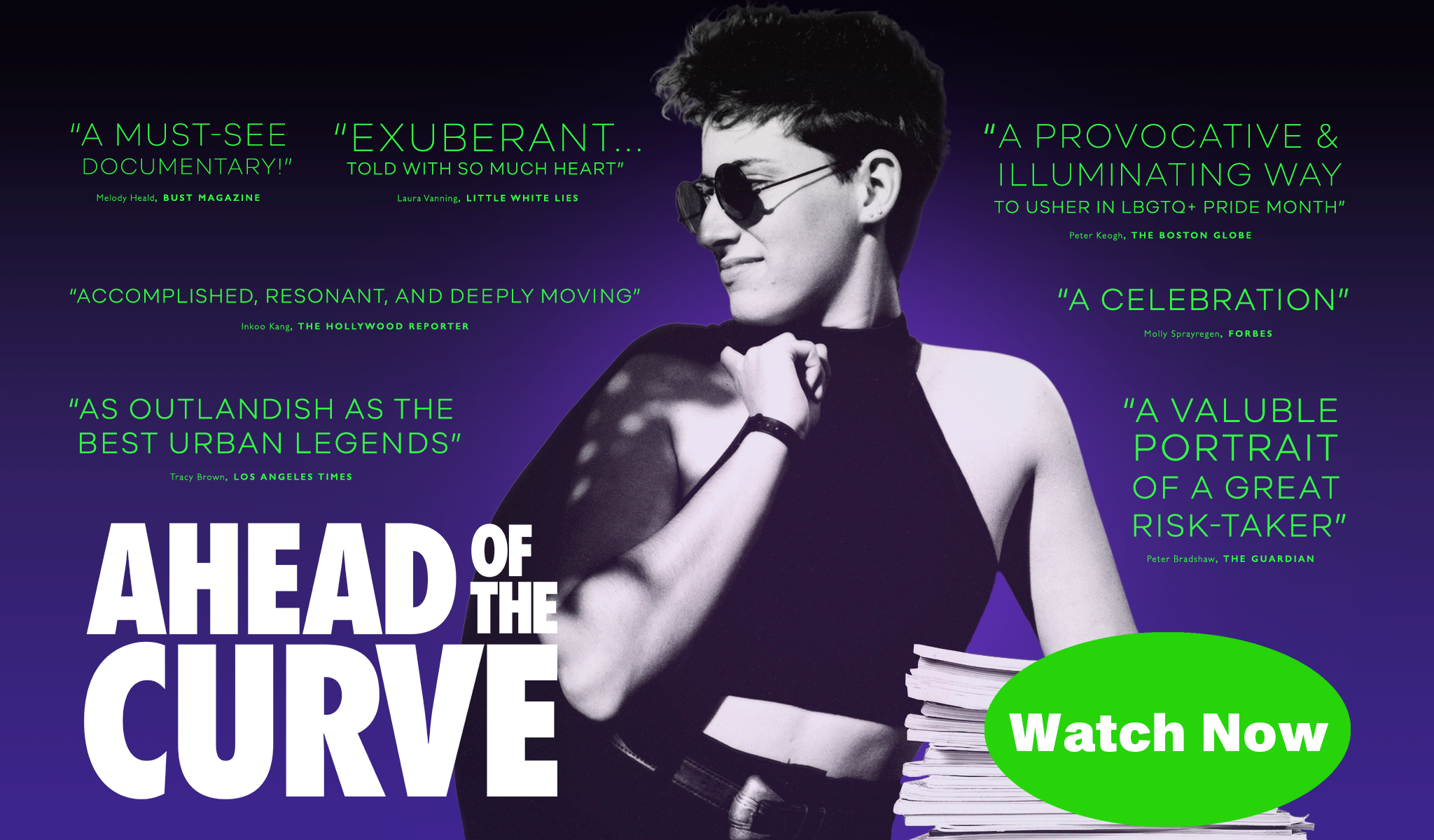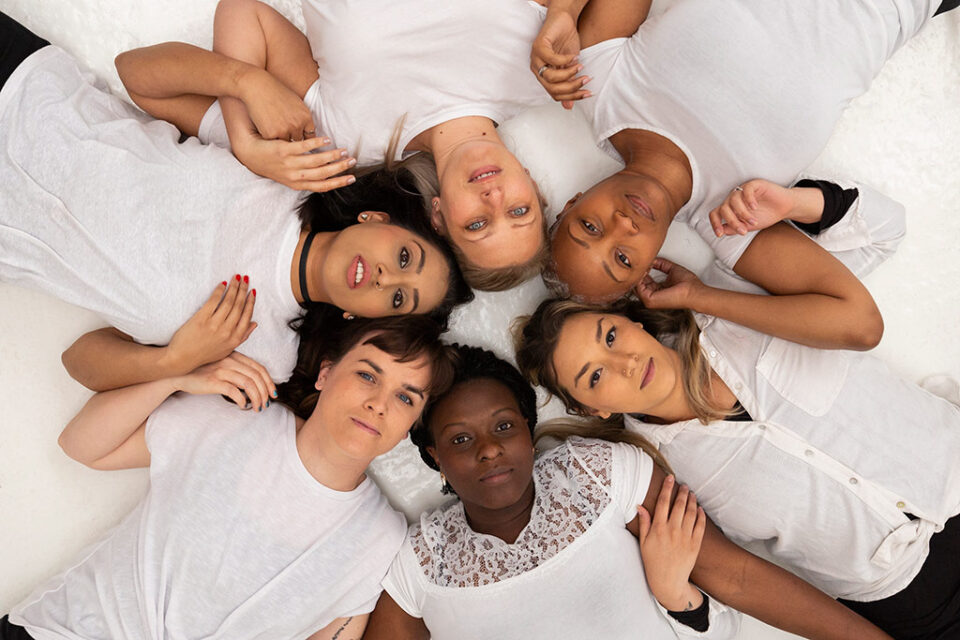Franco Stevens came on the Bay Area scene in the late-1980s, eager to immerse herself in the lesbian community she knew existed there. She went to A Different Light bookstore in the Castro looking for a magazine that would connect her to San Francisco’s vibrant lesbian scene only to be told that no such publication existed. She took a job at this same bookstore and met other women hungry for the same sort of magazine. Franco decided to create what she and other women wanted; the story of how she did that is documented in the award-winning documentary Ahead of the Curve.
In 1991, Franco’s first issue of the groundbreaking Deneuve magazine didn’t feature a lesbian celebrity on the cover; the advent of lesbian chic and the wave of “celesbians” that would follow was still a few years away. But the issue did feature Franco on the back cover looking every inch the picture of lesbian chic: relaxed, confident, and brimming with chutzpah. Franco Stevens was a self-invented pioneer of lesbian visibility, using the medium of print to hold up a mirror to lesbians everywhere so they could see themselves — and find each other.
After almost 20 years of growing the world’s best-selling newsstand publication for lesbians and queer women — which also branched into events, merchandise and dating — Franco sold her stake in the brand, citing publishing and health challenges, as well as the desire to spend more time with her family.
Australian publisher Silke Bader acquired the magazine, and for ten years tried to meet the demands of an increasingly challenging world, where the label ‘lesbian’ fractured into other identities, and a digital revolution offered increasingly free editorial content — and rewarded shorter attention spans.
“It almost felt like when I sold the magazine, my child was going off to be married,” Franco recalls of the moment she decided to let her beloved creation go. Little did she know that ten years later, her ‘child’ would come back home. “I never imagined that would happen, partially because my physical abilities haven’t changed since I had to relinquish the magazine,” she reveals. “But this turn of events has given me a great opportunity to reconnect with the community and discover what we want and need now.”
In many ways, time has made the original mission of the magazine more urgent. When Franco was in charge, she was keenly aware that she wasn’t just producing reading material — she was creating permission for same-sex attracted women to hold space in the wider culture.
“Back in the day, we couldn’t have fathomed that everybody would be connected by the Internet. Having a gorgeous, glossy, mainstream-looking magazine that you could hold in your hands was a validation of our lives and our own community. It made us visible to both each other and to the wider world.”
Foremost, Franco wanted to create a ‘home base’ for lesbians. But locating that base was a challenge.
“We went on cross-country tours to lesbian bars and bookstores, we threw parties and events to create a sense of community and to introduce women to the magazine, wherever they were,” she recalls. “I mean, how do you get the word out about something that’s never happened before when there’s no internet? You have to hit the pavement. It’s not like today where you can find women in online spaces. We literally had to go to where they were. And sometimes finding them even in their hometowns was hard.”
Franco and the Curve team kept the kind of schedule you can when you’re in your 20s. They would visit a new city every day, do a radio show, a bookstore reading, a meet-and-greet in a coffee shop, and then head to a party in a club or bar that night, and crash with some local women or pack into a motel room if they had the cash. “The magazine became a way for women to connect when they had no other way to meet each other,” says Franco. “Talk about some powerful validation that you’re not alone.”
When Franco reaquired the publication in early 2021, the home base she had created with her magazine would become The Curve Foundation, a non-profit organization conceived to empower lesbians, queer women, trans women, and non-binary people of all races, ages and abilities to share our stories, connect and raise visibility. Franco donated the magazine to The Curve Foundation and feels thrilled to have the new Executive Director take the lead on the re-envisioned publication going forward.
The Curve Foundation has formed a partnership with NLGJA: The Association of LQBTQ Journalists to create an award for emerging journalistic writers focused on LGBTQ+ women’s stories. “We need to amplify the most marginalized voices in our movement now, focusing on inclusion and on cross-movement work around racial justice, immigration, disability rights,” says Franco. “The Curve Foundation aims to be a powerful platform for this work.”
Along with reclaiming the iconic brand and mission, The Curve Foundation houses a living, searchable archive of 30 years of Curve and Deneuve back issues that now anyone can access. The seeds of many current cultural conversations around identity, race, inclusion, and rights can be found in the early articles. These archives document the history and voices of the lesbian movement. Franco sees an opportunity for a robust intergenerational conversation and believes “It’s incredibly powerful for young people to receive accurate stories about their lineage and where they come from, and for elders to help support new ideas that the young ones bring in.” No other existing resource so fully documents queer women’s past and present and there is no doubt that women of a certain age who were part of Curve’s history will be happy to see their stories preserved and honored.
The story behind Curve magazine and The Curve Foundation comes together in the new documentary, Ahead of the Curve. When Franco’s wife, Jen Rainin, came to her with the idea to make a movie about her spouse’s incredible lesbian life, Franco’s first thought was that she was far more comfortable behind the scenes. “I said I’m not sure I want to do that.” But she trusted Jen and her creative partner Rivkah Beth Medow, and when she realized the power of her story, she embraced the opportunity to share the good, the bad, and everything in between in her adventures with Curve.
It was nearly two-thirds of the way through filming when Franco got a call from the owner/publisher Silke Bader, who was having trouble keeping the magazine going. Jen, Rivkah and Franco went from filming what they thought was their last scene, to making it the opening scene! The story shifted from a historical biopic to Franco’s journey to learn whether or not Curve’s mission was still needed today. Ahead of the Curve answers that question with a resounding “yes!” as Franco connects with the community and some of the queer women leading the movement today.
Jen says, “Visibility and representation are the most powerful tools to protect LGBTQ+ women, and my wife knew this 30 years ago. Her work moved the nation forward socially and politically by creating space, visibility, and empathy for anyone who identified as lesbian.” The film Ahead of the Curve chronicles Franco’s journey from the ‘90s to today, includes interviews with Melissa Etheridge and Lea DeLaria, and amplifies the voices of leaders including Kim Katrin, Denice Frohman, Andrea Pino-Silva, Amber Hikes, and Jewelle Gomez. It will release widely on June 1, introducing The Curve Foundation to the world to continue Franco’s critical work into the future.
When Franco visualizes the future of all things Curve she sees herself interacting with a community rich in history, purpose, and inclusion. “I think that using all the tools at our disposal today to take control of our own stories and lift up the full beautiful diversity of our community would be really powerful. That’s my dream for Curve.”

